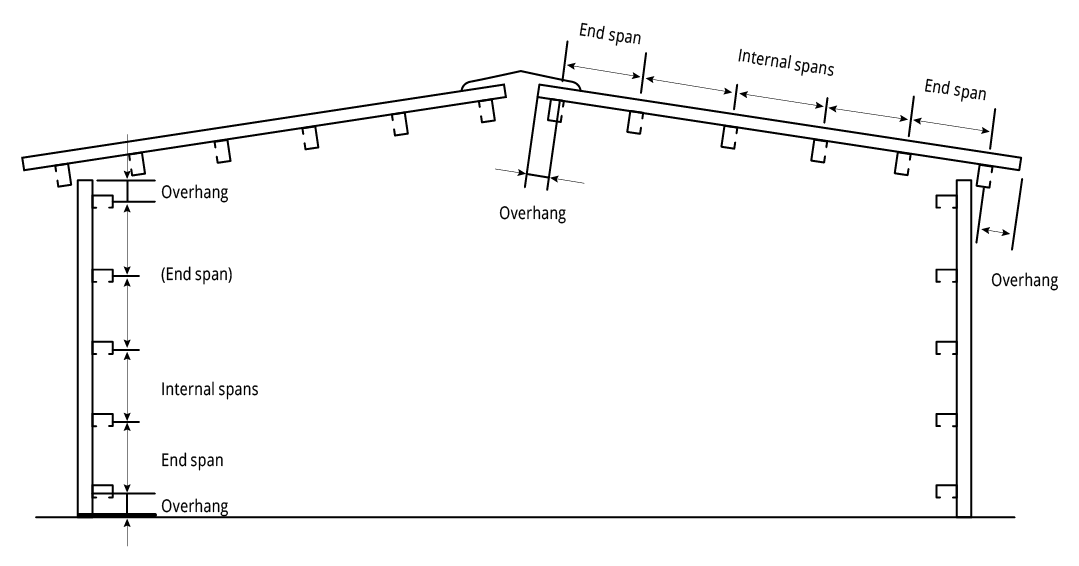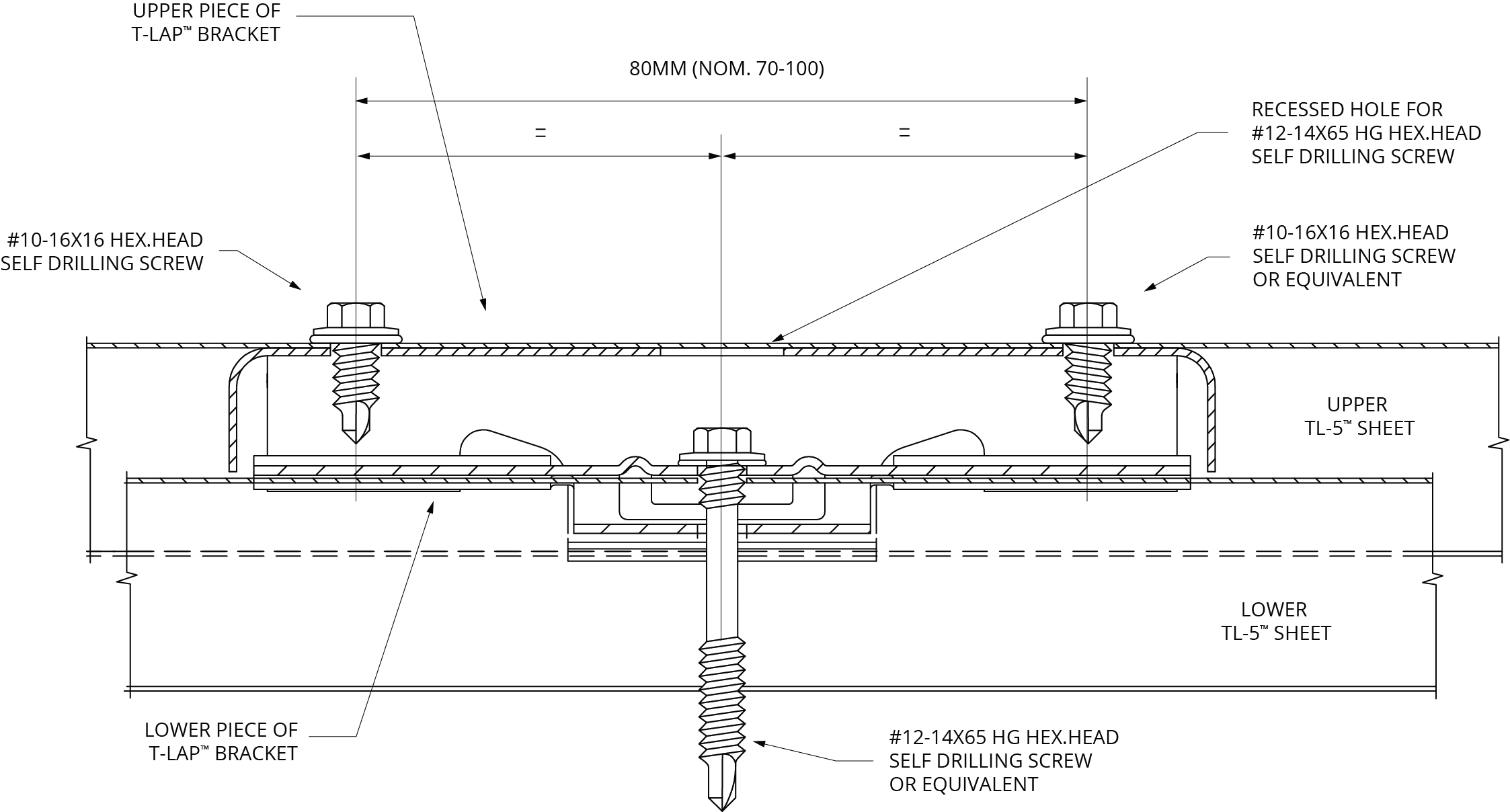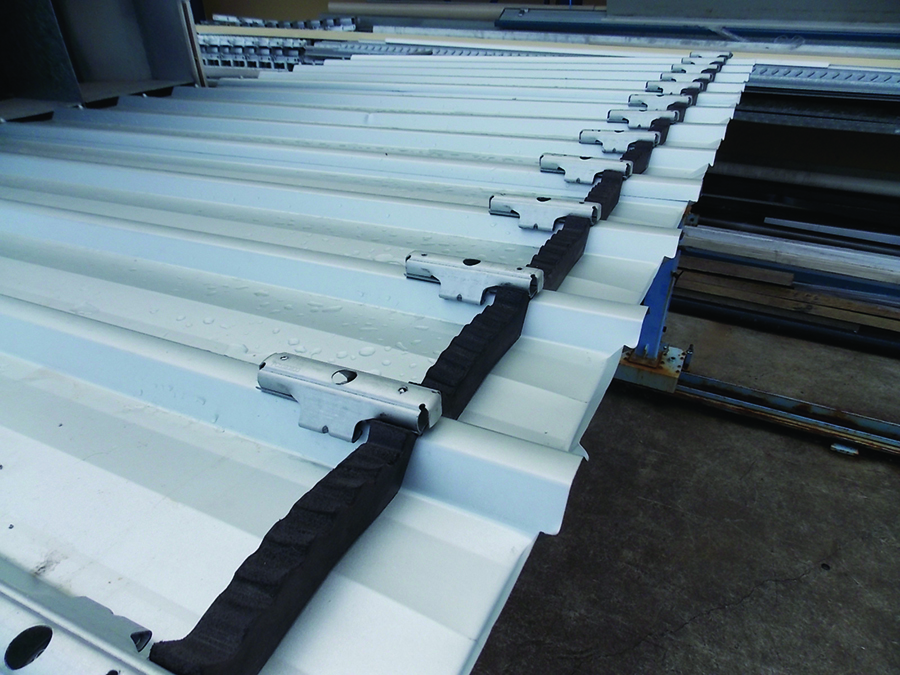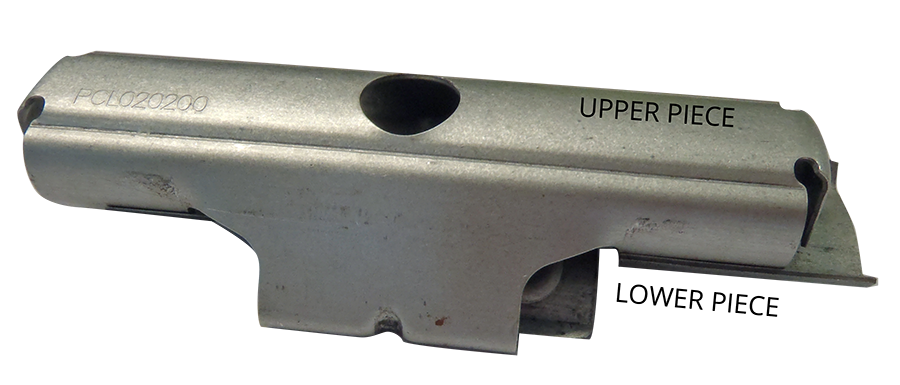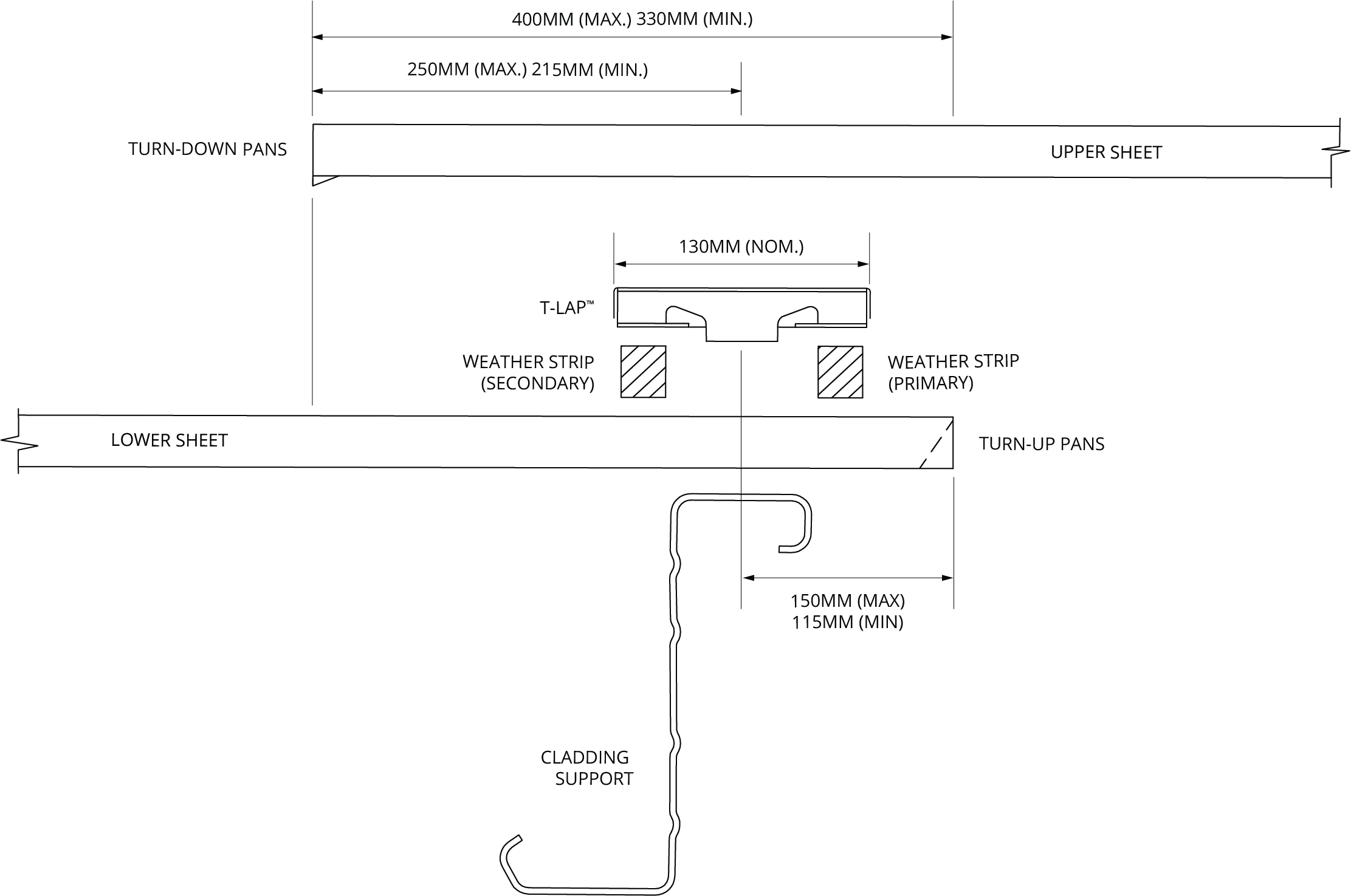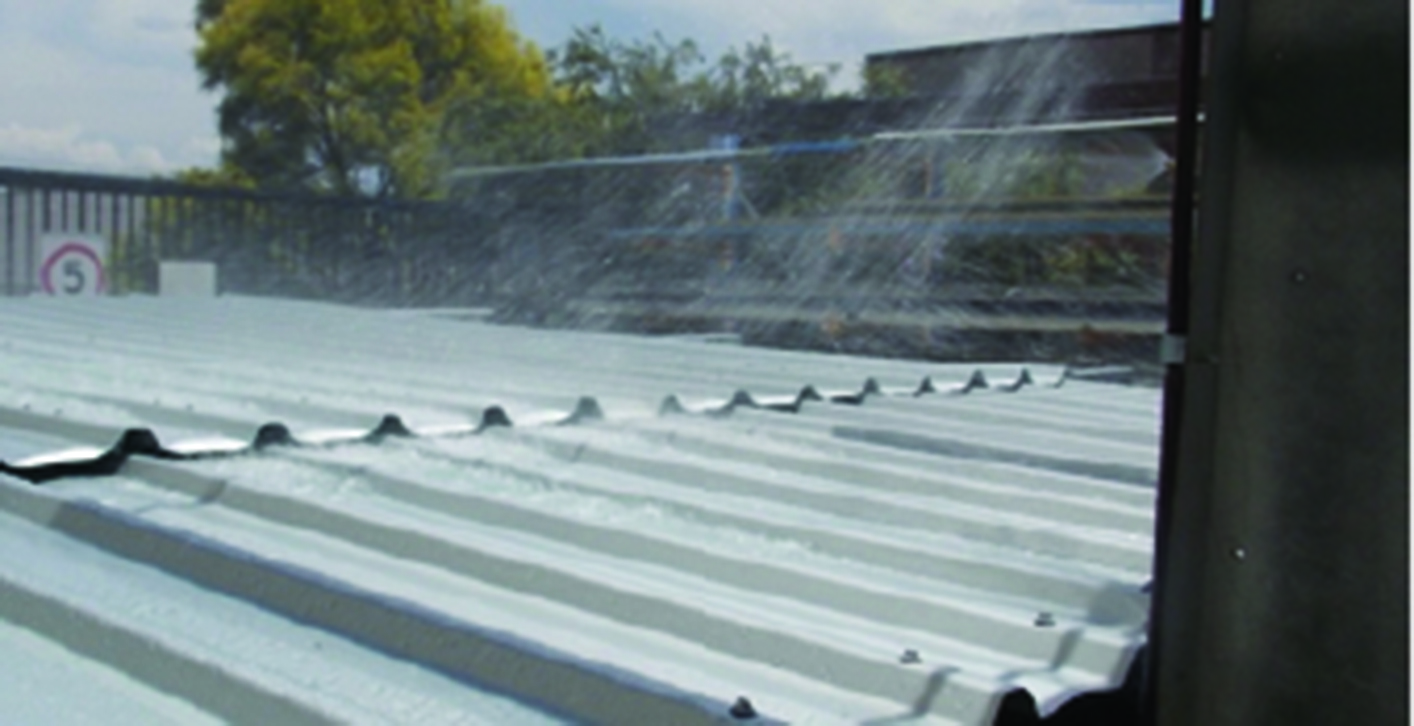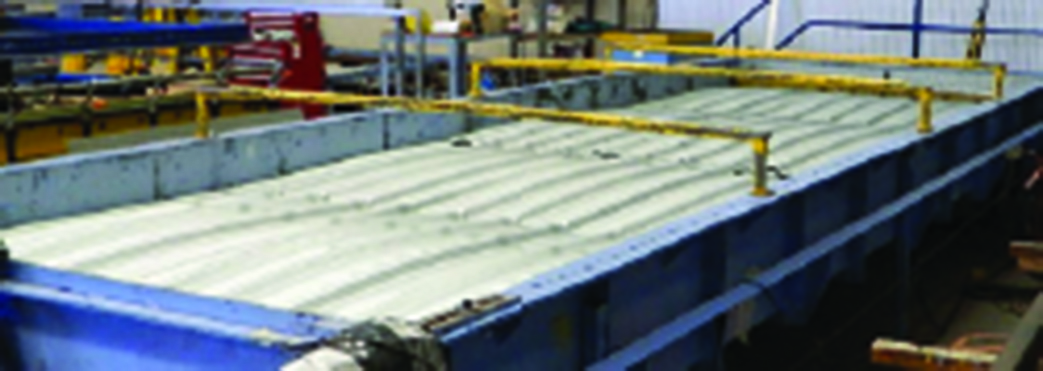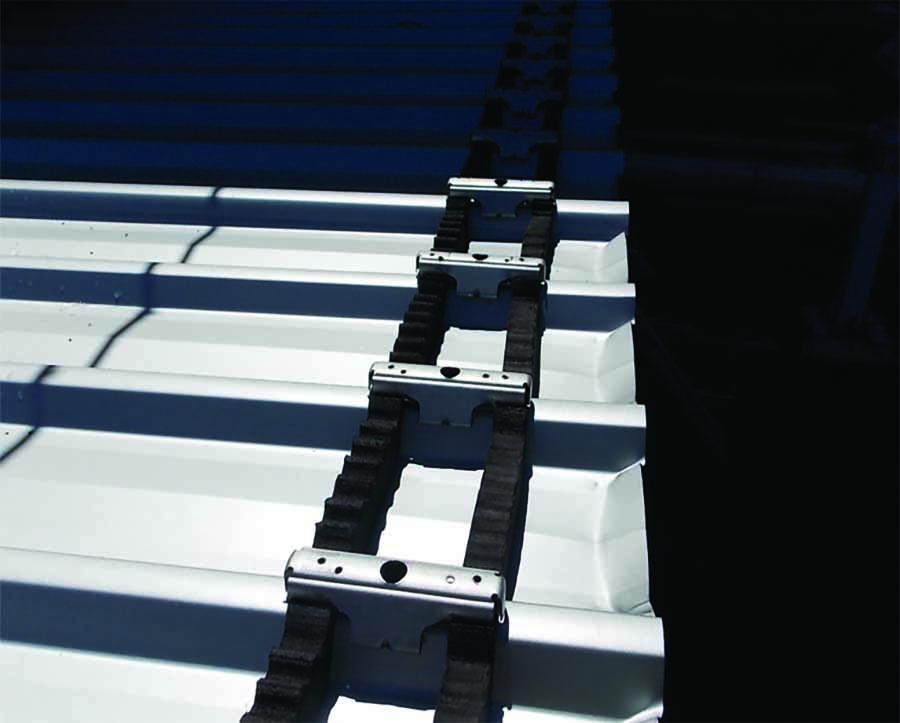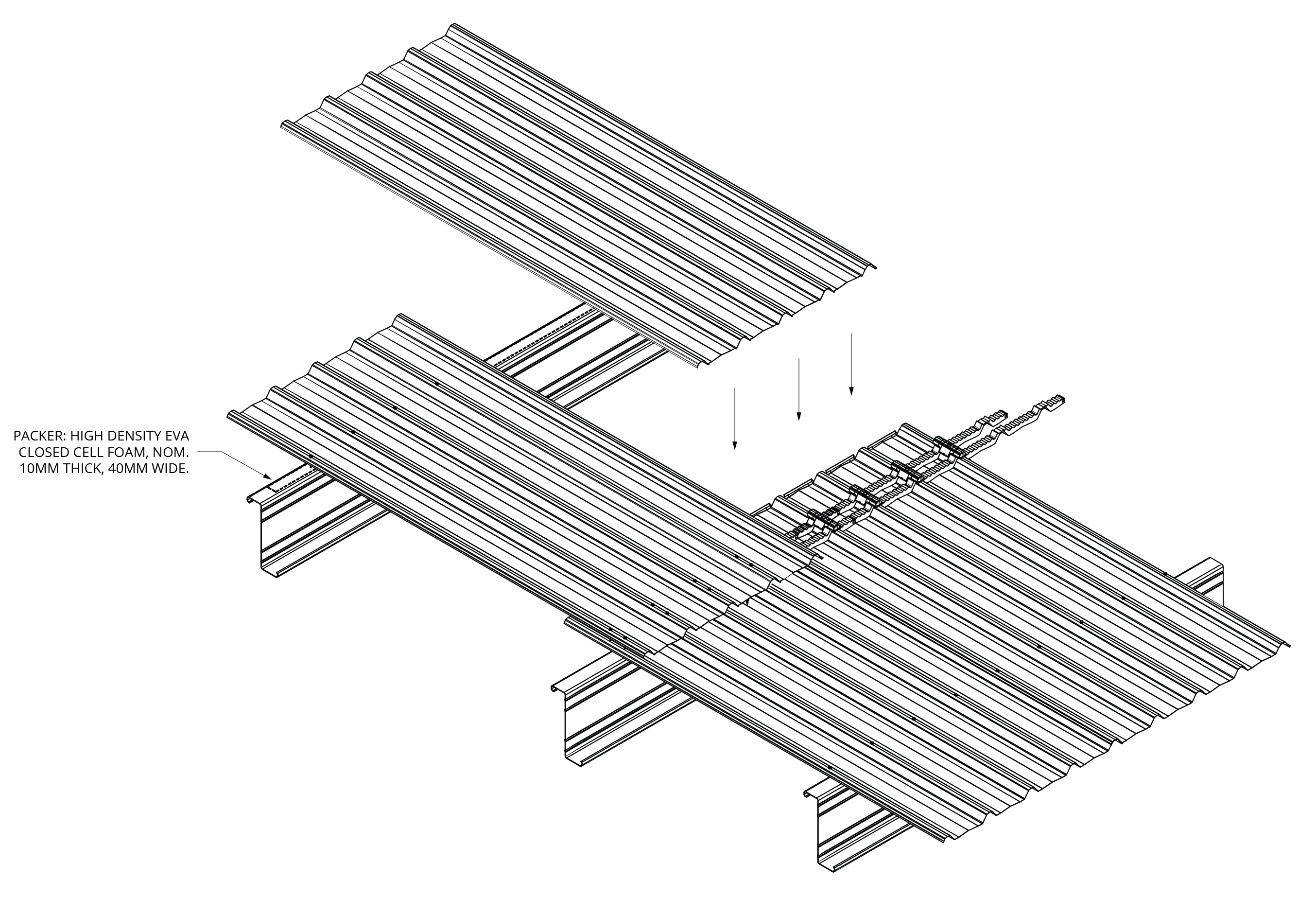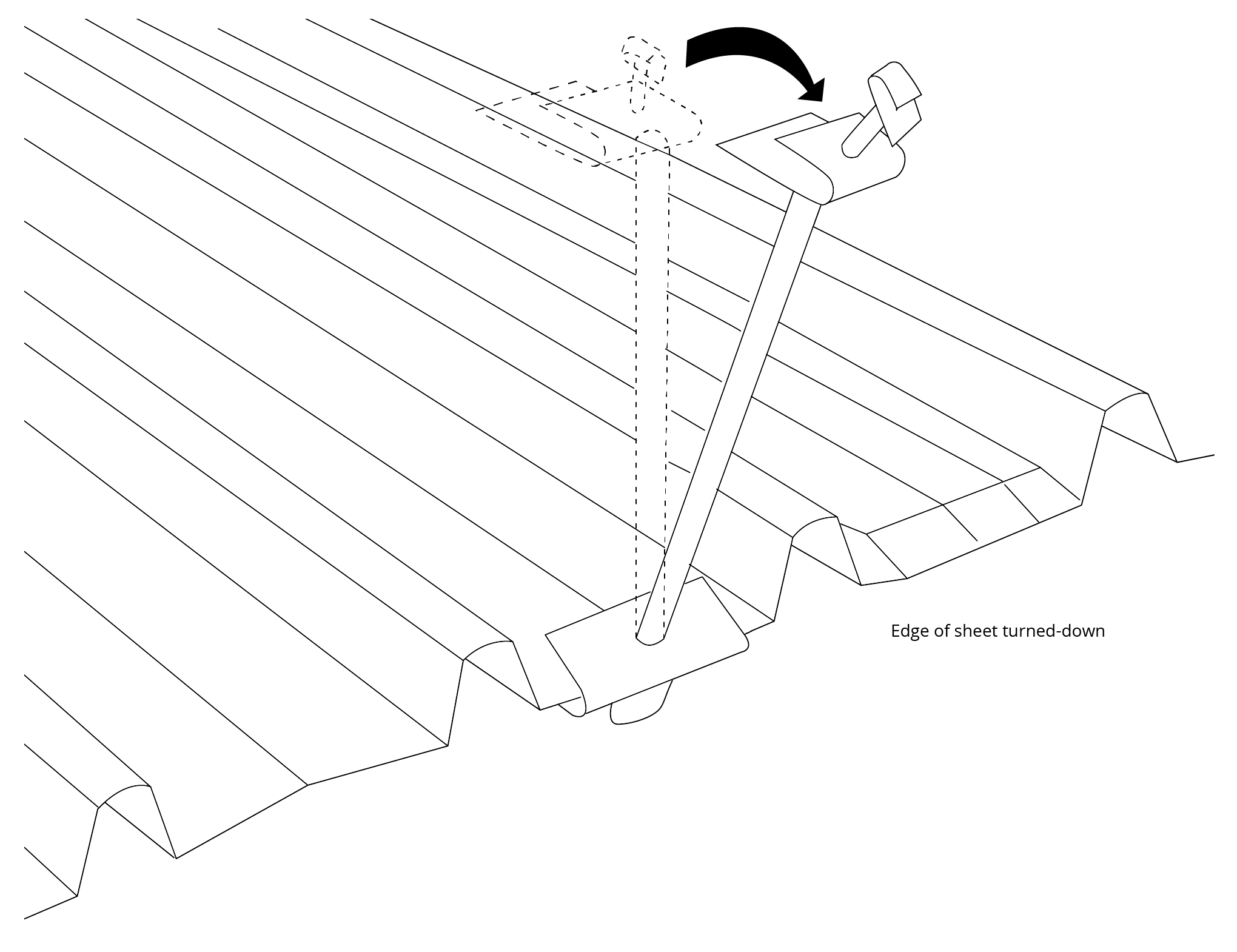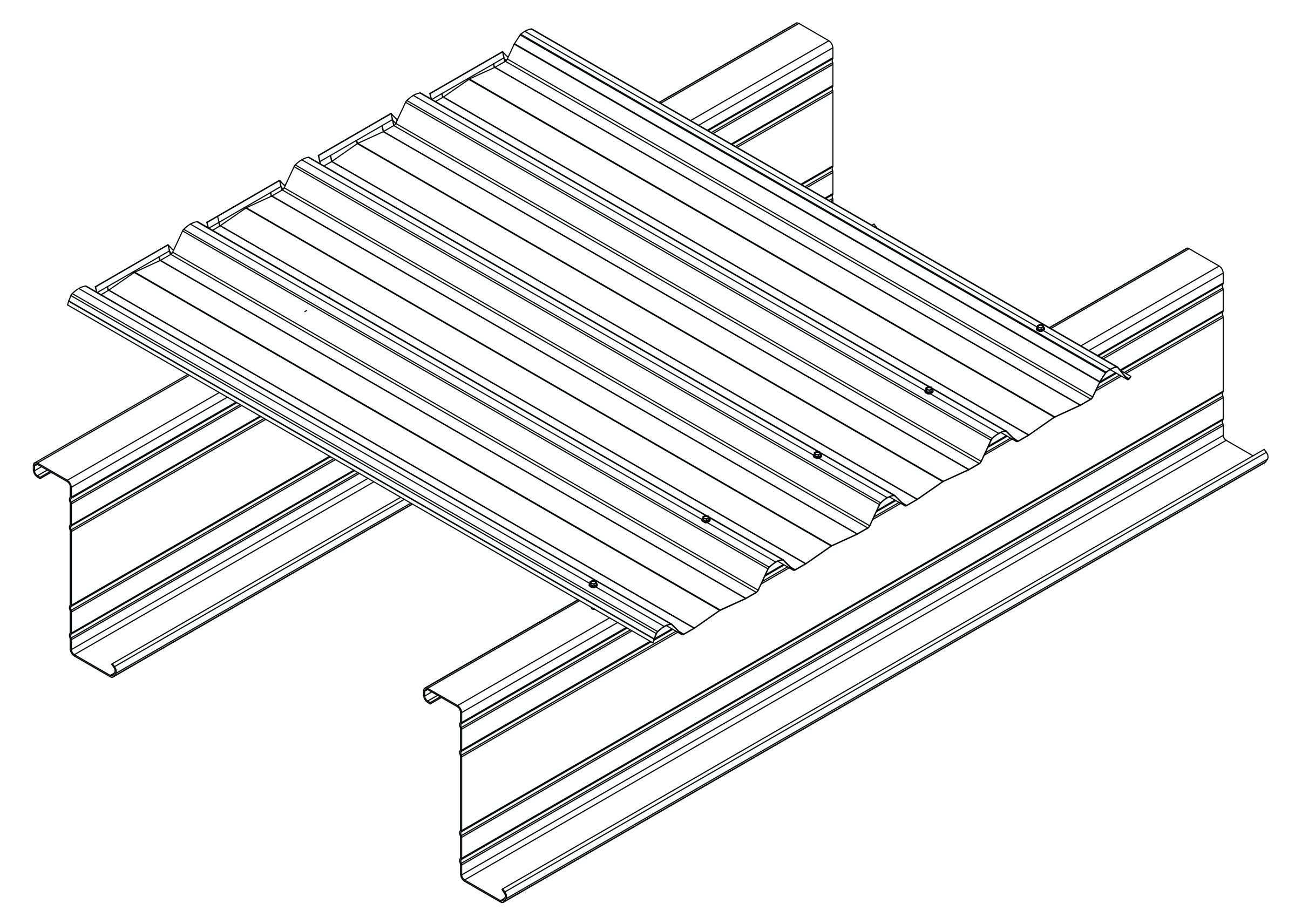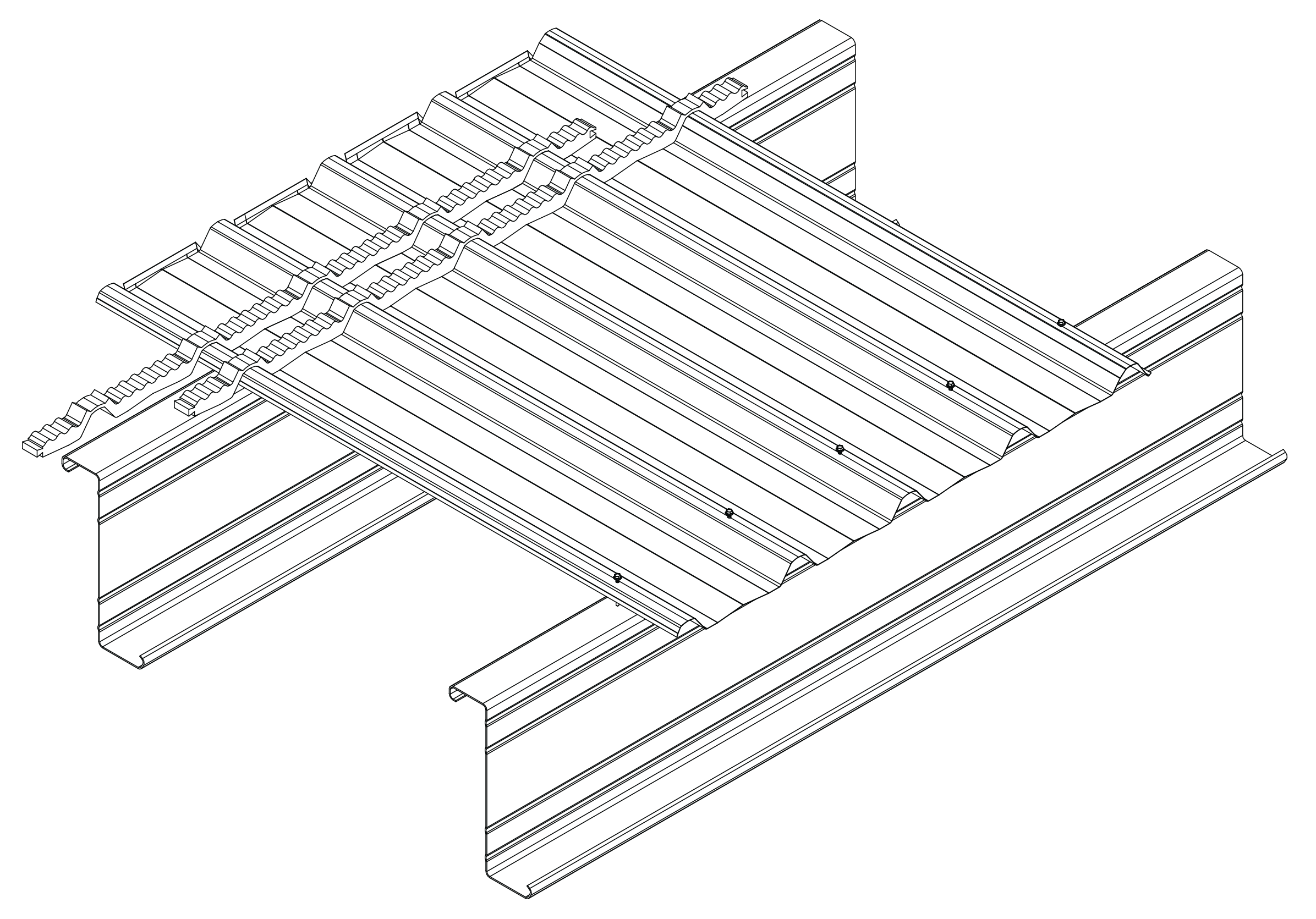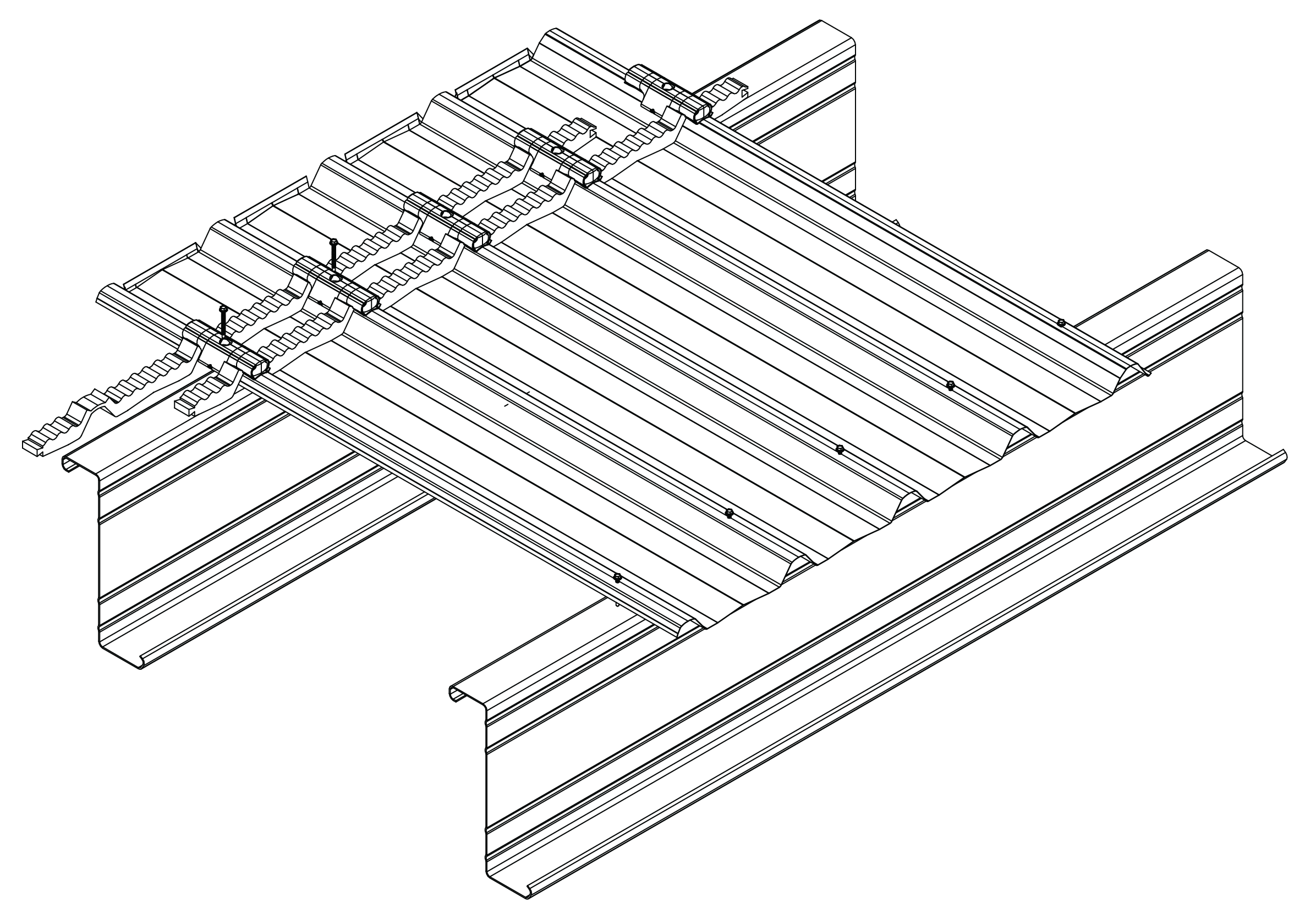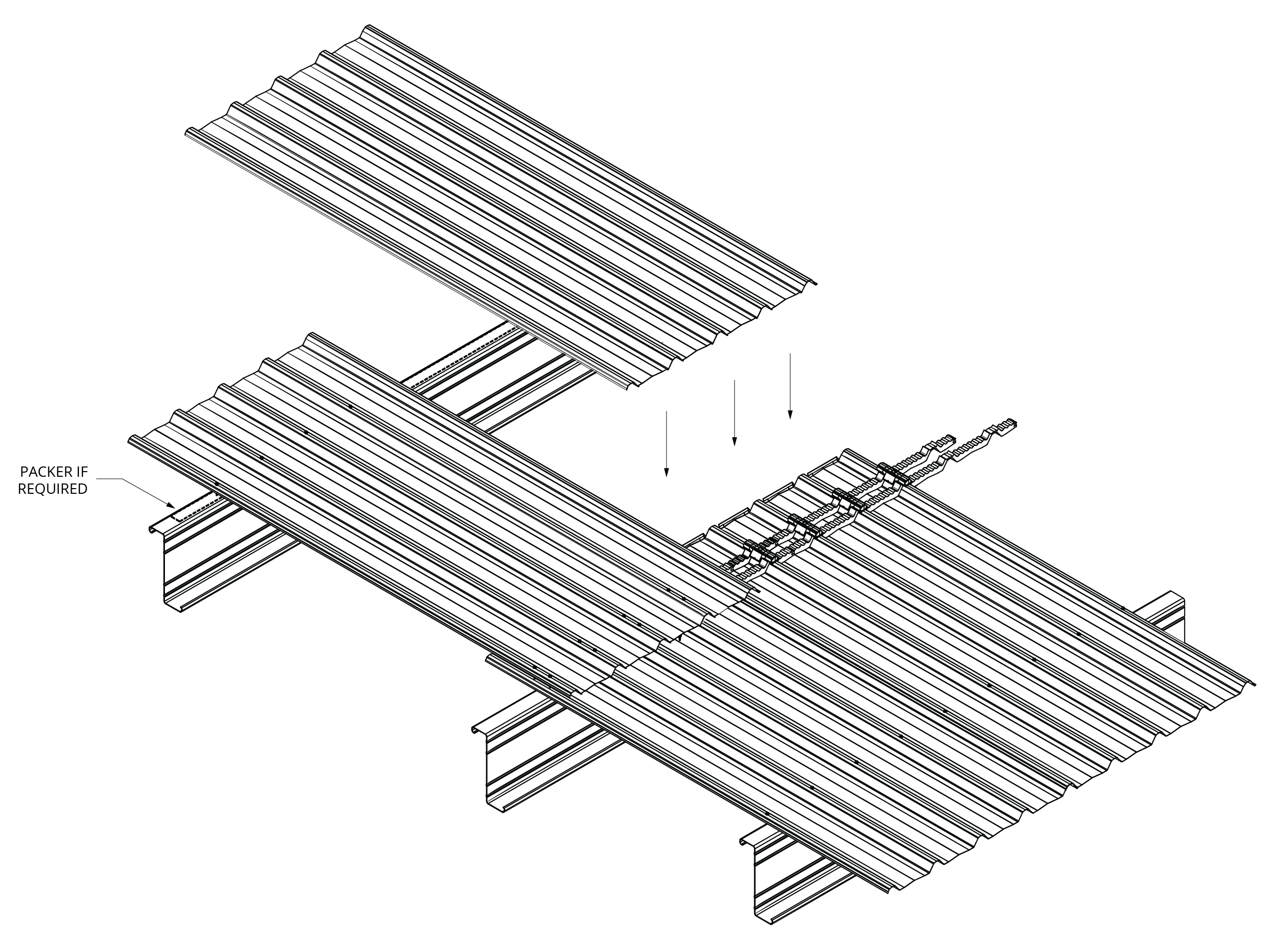
About TL-5™
TL-5™ is both versatile and economical, making it perfect for wall panelling, cladding or even short span roofing. The TL-5™ profile is quick and easy to install, long lasting and durable. With a rib height of 28mm, a large sheet coverage of 762mm, and specially design capillary grooves, TL-5™ offers excellent value for money and complete watertightness.
Available in long lasting ZINCALUME® and COLORBOND® steel, this product is perfect for commercial or domestic use. Depending on location, actual product supplied may vary from image shown.
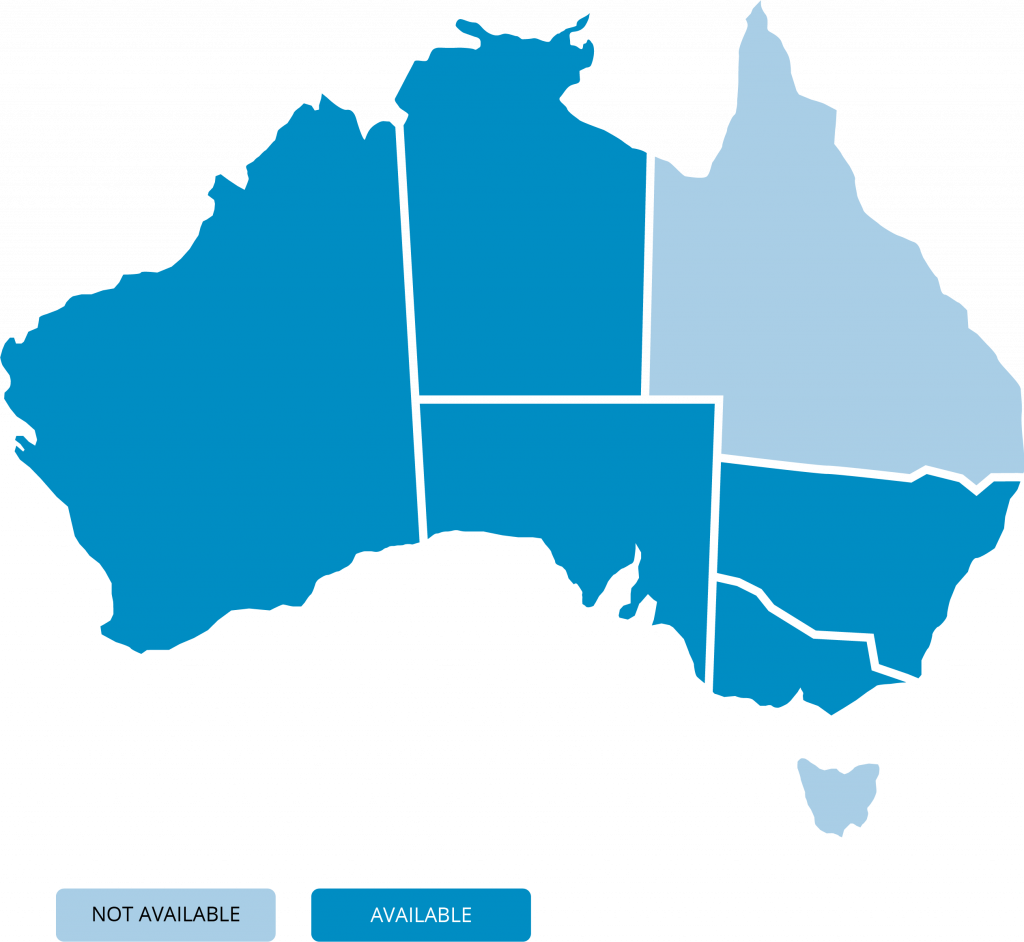
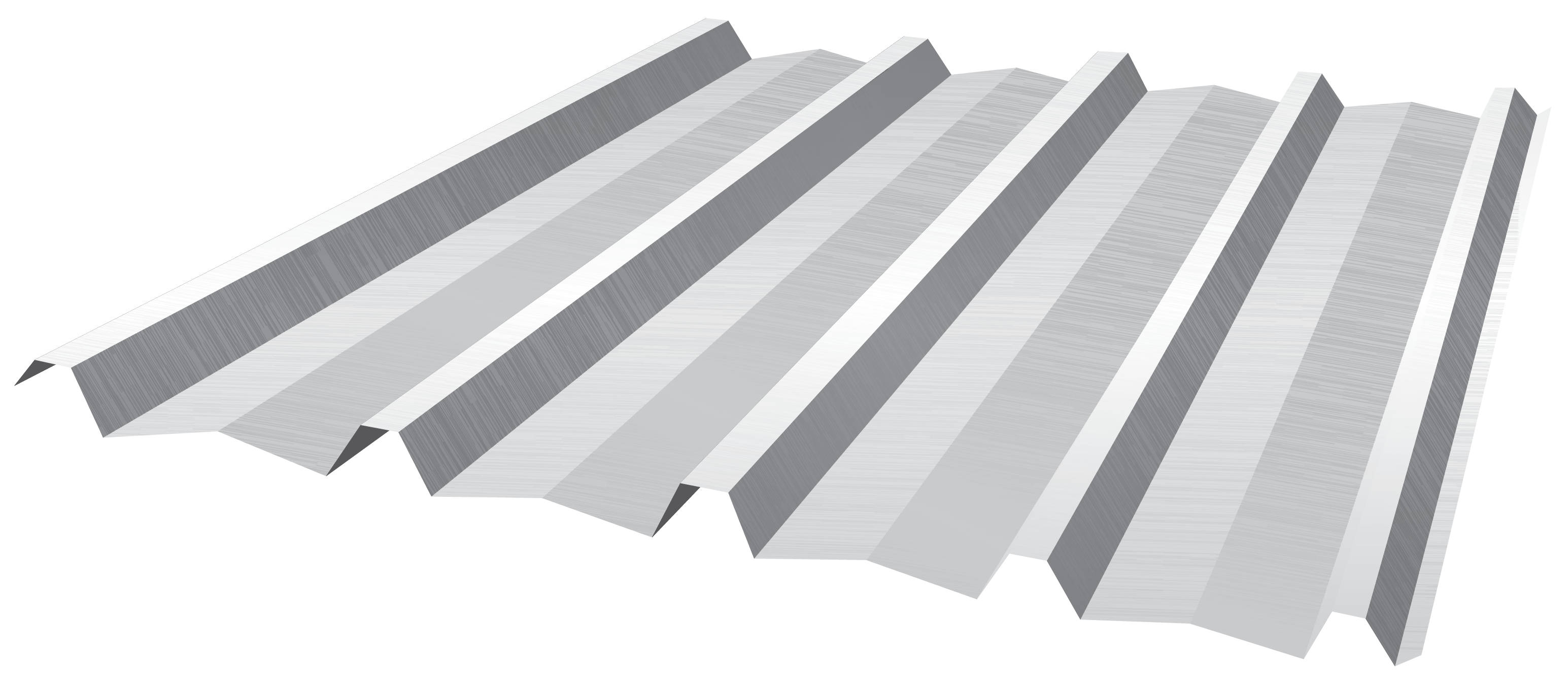

Material Specifications
Material Specifications
| Property | Notes | ||||
| Base Metal Thickness (mm) | 0.35 | 0.42 | 0.48 | BMT | |
| Mass / Unit Length | ZINCALUME® | 2.75 | 3.26 | 3.70 | kg/m |
| COLORBOND® | 2.80* | 3.32* | 3.76* | ||
| Mass / Unit Area | ZINCALUME® | 3.60 | 4.28 | 4.86 | kg/m2 |
| COLORBOND® | 3.68* | 4.35* | 4.93* | ||
| Minimum Yield Strength | G550 | Base Steel Designation | |||
| Coating Class | Z600 (Heritage Galvanised) AM100 (COLORBOND® Steel ) AM125 (ZINCALUME®) AM150 (COLORBOND® Ultra Steel) Z450 (Galvanised) | Minimum Coating g/m2 of Zinc - Aluminium |
|||
| Coverage (mm) | 762 | ||||
| Tolerance | Length: +0mm, -15mm, Width: +4mm, -4mm | ||||
Note:
- TL-5TM is manufactured from materials in accordance to AS 1397 and AS 2728. It is to be installed in accordance with AS 1562 and HB 39.
- The sectional properties are theoretical values per sheet width. These properties are gross values only.
- *is based on Standard COLORBOND®; single-sided material. For other painted steel options please contact a Fielders® representative.
Rainfall Capacity
Penetrations will alter the flow of water on a roof. For further information, please refer to sections "Rainfall Intensity" and "Water Carrying Capacity and Rainwater Run-Off". For assistance in design of roofs with penetrations, please seek advice from your local Fielders representative.
Maximum Roof Length (m)
| Roof Slope (degrees) | Rainfall Capacity (mm/hr) | ||||||
| 100 | 150 | 200 | 250 | 300 | 400 | 500 | |
| 2 | 220 | 146 | 110 | 88 | 73 | 55 | 44 |
| 3 | 257 | 172 | 129 | 103 | 86 | 64 | 51 |
| 5 | 320 | 214 | 160 | 128 | 107 | 80 | 64 |
| 10 | 439 | 293 | 220 | 176 | 146 | 110 | 88 |
Note:
- Minimum recommended slope is 2°. Sheet lengths greater than 24m are not recommended due to thermal expansion and contraction.
Load Span Tables
The allowable spans have been determined from tests carried out in accordance with the following Australian Standards (wind load available by region): AS 1562.1 :1992, “Design and installation of sheet roof and wall cladding - Metal” and AS 4040:1992, “Methods of testing sheet roof and wall cladding”.
Wind Pressure Capacities
TL-5™ cladding offers the full benefits of the latest methods for modelling wind pressures. The wind pressure capacity table is determined by full scale tests conducted at Fielders' NATA-registered testing laboratory, using the direct pressure-testing rig.
Testing was conducted in accordance with AS 1562.1:1992 Design and installation of sheet roof and wall cladding— Metal, and AS 4040.2:2002 Resistance to Wind Pressure for Non-cyclonic Regions.
The pressure capacities for serviceability are based on a deflection limit of (span/120) + (maximum fastener pitch/30).
The pressure capacities for strength have been determined by testing the cladding to failure (ultimate capacity). These pressures are applicable when the cladding is fixed to a minimum of 1.0mm, G550 steel. For material less than 1.0mm thick, please contact your local Fielders representative.
Figure TL NC 002 End Spans, Internal Spans and Overhangs illustrates the terminology end spans, internal spans, and overhangs and their reference to the supporting substructure. This terminology has been used in the following Maximum Recommended Span and Wind Load Capacity tables. Long lengths and a special anti-capillary groove in the side-lap allows you to use TL-5 cladding on roof pitches as low as 2° (1 in 30).
Wind Load Capacity: Limit State Design: Crest Fixed: 0.42mm BMT
| Span (mm) | Single Span | End Span | Internal Span | |||
| Serv. (kPa) | Strength (kPa) | Serv. (kPa) | Strength (kPa) | Serv. (kPa) | Strength (kPa) | |
| 900 | 3.91 | 8.35 | 3.63 | 5.85 | 4.18 | 7.95 |
| 1200 | 2.83 | 6.45 | 3.08 | 5.30 | 3.42 | 6.55 |
| 1500 | 1.87 | 4.75 | 2.55 | 4.80 | 2.83 | 5.25 |
| 1800 | 1.16 | 3.60 | 2.06 | 4.30 | 2.36 | 4.30 |
| 2100 | 0.75 | 3.00 | 1.62 | 3.80 | 1.94 | 3.65 |
| 2400 | 0.53 | 2.75 | 1.22 | 3.25 | 1.56 | 3.30 |
| 2700 | - | - | 0.85 | 2.75 | 1.23 | 3.05 |
| 3000 | - | - | 0.50 | 2.25 | 0.97 | 2.85 |
Note:
- Values are based on fixing into steel supports with a minimum thickness of 1.0mm.
- Values are based on no insulation under the sheeting.
- Serv. denotes serviceability
Wind Load Capacity: Limit State Design: Crest Fixed: 0.48mm BMT
| Span (mm) | Single Span | End Span | Internal Span | |||
| Serv. (kPa) | Strength (kPa) | Serv. (kPa) | Strength (kPa) | Serv. (kPa) | Strength (kPa) | |
| 900 | 5.06 | 11.60 | 5.13 | 8.00 | 5.96 | 8.55 |
| 1200 | 3.34 | 9.60 | 3.96 | 6.55 | 4.66 | 7.35 |
| 1500 | 2.06 | 7.75 | 2.93 | 5.30 | 3.54 | 6.25 |
| 1800 | 1.15 | 6.10 | 2.13 | 4.35 | 2.72 | 5.40 |
| 2100 | 0.71 | 4.75 | 1.54 | 3.65 | 2.22 | 4.75 |
| 2400 | 0.50 | 3.60 | 1.12 | 3.25 | 1.92 | 4.30 |
| 2700 | 0.42 | 2.65 | 0.82 | 2.95 | 1.64 | 3.85 |
| 3000 | - | - | 0.58 | 2.75 | 1.38 | 3.45 |
Note:
- Values are based on fixing into steel supports with a minimum thickness of 1.0mm.
- Values are based on no insulation under the sheeting.
- Serv. denotes serviceability
Wind Load Capacity: Limit State Design: Valley Fixed: 0.35mm BMT
| Span (mm) | Single Span | End Span | Internal Span | |||
| Serv. (kPa) | Strength (kPa) | Serv. (kPa) | Strength (kPa) | Serv. (kPa) | Strength (kPa) | |
| 900 | 2.28 | 4.60 | 2.77 | 5.35 | 2.73 | 6.30 |
| 1200 | 1.80 | 3.05 | 2.76 | 4.75 | 2.57 | 5.75 |
| 1500 | 1.39 | 2.30 | 2.47 | 4.00 | 2.30 | 4.90 |
| 1800 | 1.05 | 1.85 | 1.93 | 3.15 | 1.96 | 3.90 |
| 2100 | 0.75 | 1.55 | 1.31 | 2.40 | 1.58 | 2.95 |
| 2400 | 0.48 | 1.35 | 0.80 | 1.85 | 1.23 | 2.25 |
| 2700 | - | - | 0.51 | 1.60 | 0.92 | 1.80 |
| 3000 | - | - | 0.40 | 1.50 | 0.65 | 1.60 |
Note:
- Values are based on fixing into steel supports with a minimum thickness of 1.0mm.
- Values are based on no insulation under the sheeting.
- Serv. denotes serviceability
Maximum Recommended Roof Cladding Span: Crest Fixed
| Wind Region | Base Metal Thickness (mm) | Terrain Category 3 | ||
| Single (mm) | End (mm) | Internal (mm) | ||
| B | 0.42 | 1100 | 1300 | 1900 |
| 0.48 | 1600 | 1850 | 2600 | |
Importance Level 2
Terrain Category 3
Maximum Roof Height H = 10m
External Pressure Coefficient:
Cpe = -0.65 for walling
Cpe = -0.9 for roofing
Internal Pressure Coefficient:
Cpi = 0.2
Local Pressure Factor:
kL = 2.0 (end & single span)
kL = 2.0 (internal span)
Table TL RS NC 002A - TL-5™ Non-Cyclonic
Note:
- Maximum roofing spans comply with both strength and serviceability wind pressure requirements.

Roof Fixing Details
1. Crest Fixed - 12g-14x68mm Hex Heads one per crest
Maximum Recommended Wall Cladding Span: Valley Fixed
| Wind Region | Base Metal Thickness (mm) | Terrain Category 2 | Terrain Category 3 | ||||
| Single (mm) | End (mm) | Internal (mm) | Single (mm) | End (mm) | Internal (mm) | ||
| A | 0.35 | 1550 | 2000 | 2500 | 1750 | 2200 | 2500 |
| 0.42 | 1650 | 2200 | 2500 | 1900 | 2500 | 2500 | |
| 0.48 | 1800 | 2500 | 2500 | 2100 | 2500 | 2500 | |
| B | 0.35 | 1500 | 1575 | 2500 | 1700 | 1950 | 2500 |
| 0.42 | 1600 | 1800 | 2500 | 1850 | 2500 | 2500 | |
| 0.48 | 1750 | 2050 | 2500 | 2000 | 2500 | 2500 | |
Importance Level 2
Terrain Category 3
Maximum Roof Height H = 10m
External Pressure Coefficient:
Cpe = -0.65 for walling
Cpe = -0.9 for roofing
Internal Pressure Coefficient:
Cpi = 0.2
Local Pressure Factor:
kL = 2.0 (end & single span)
kL = 2.0 (internal span)
Table TL RS NC 001 - TL-5™ Non-Cyclonic
Note:
- Maximum walling spans comply with both strength and serviceability wind pressure requirements.
Pierce Fixing
Fasteners must be selected to match the life expectancy of the cladding material. Recommendations from fastener manufacturers should be sought. Only fasteners complying with AS 3566:2002 and those that are compatible with the roofing material should be used for its fastening.
Notes:
All fasteners used externally should be fitted with an EPDM seal (washer). Do not use punches to form fastener holes.
Pierce Fixing Table
| Fixing Supports | Crest Fixing | Valley Fixing | Side Lap Fixing |
| Steel 1.0 to 3.5mm | 12-14x45, Metal Teks HG, HH or AutoTeks 12-14x50 | 10-16x16, Metal Teks, HH | 10g-16x16mm Hex Head Tek Screws with seal |
| Timber Hardwood | 12-11x65, Type 17 HG, HH | 10-12x25, type 17, HH or 10-16x25 Designer Head or 12-11x25, Type 17, HH |
|
| Timber Softwood | 12-11x65, Type 17 HG, HH or Roof Zips M6-11x65 | 10-12x25, type 17, HH or 10-16x25 Designer Head or 12-11x25, Type 17, HH or Roof Zips M6-11x25 |
|
| Metal Battens (0.55 to 1.0mm) | Roof Zips M6-11x50 | 10-16x16, Metal Teks, HH or 10-16x25 Designer Head or Roof Zips M6-11x25 |
Fastener Spacings - Non-Cyclonic
Crest Fastener Location

4 Fasteners per sheet – Internal and end supports.
Roofing should be lapped away from the prevailing weather.
Valley Fastener Location (Wall Only)

4 Fasteners per sheet – Internal and end supports
Table TL FS NC 001
Note:
1. Do not use punches to form fastener holes. AQUABLOK™ System
The maximum recommended support spacings are based on testing in accordance with AS 1562.1:1992, AS 4040.1:1992 and AS 4040.2:1992.
Roof spans consider both resistance to wind pressure and light roof traffic (traffic arising from incidental maintenance). Wall spans consider resistance to wind pressure only.
The pressure considered is based on buildings up to 10m high in Region B, Terrain Category 3, Ms=0.85, Mi=1.0, Mt=1.0 with the following assumptions made: ROOFS: Cpi=+0.20, Cpe=-0.90, Kl=2.0 for single + end spans, Kl=1.5 for internal spans. WALLS: Cpi=+0.20, Cpe=-0.65, Kl=2.0 for single spans, Kl=1.5 for internal spans. These spacings may vary by serviceability and strength limit states for particular projects.
Fastening Sheets to Supports
TL-5™ profile is pierce-fixed to timber or steel supports. This means that fastener screws pass through the sheeting.
You can place screws for TL-5™ cladding through the crests or in the pans. To maximise watertightness, always place roof screws through the crests.
For walling, you may use either crest or pan-fixing.
Always drive the screws perpendicular to the sheeting, and in the centre of the corrugation or rib. Don’t place fasteners less than 25mm from the ends of sheets.
Side Lap Fastening
The edge of TL-5TM cladding with the anti-capillary groove is always the underlap (see figures below). It is generally considered good practice to use fasteners along side-laps however, when cladding is supported as indicated in maximum support spacings, side-lap fasteners are not usually needed for strength.
End Laps
End-laps are not usually necessary because TL-5TM cladding is available in long lengths. If you want end-laps, seek advice from your local Fielders representative on the sequence of laying and the amount of overlap.
Insulation
Care needs to be taken when installing insulation with roof sheeting. When insulation thickness up to 50mm are installed the screws detailed in Table TL PF NC 001 may need to be increased depending on the thickness and density of the insulation. When the screw is properly tightened into metal there should be a minimum of three (3) threads protruding past the support being fixed in to. For timber the screw must penetrate the timber as much as the screws detailed in Table TL PF NC 001 do without insulation.
For insulation thicknesses greater than 50mm Fielders® recommend the use of a thermal spacer to help maintain Rw values as well as minimising any bulging in the profile caused by the insulation.
TL-5™ Installation Procedure
For installation procedures see section “Typical Pierce Fix Installation Guide”. For general handling instructions refer to section “Maintenance and Care”.
Turning of Roof Sheeting Ends
It is usual to allow roof sheets to overlap into gutters by about 50mm. If the roof pitch is less than 25° or extreme weather is expected, the pans of sheets should be turned-down at lower ends, and turned-up at upper ends by about 80°. Refer to section “Flashings, Cappings & Ends of sheets”.
Sheet-Ends on Low Slopes
When TL-5™ cladding is laid on slopes of 5° or less, cut back the corner of the under-sheet, at the downhill end of the sheet, to block capillary action.
Curving
For details regarding spring fixing and crank curving of TL-5™ sheets, please see section “Curving of Steel Decks”.
Maximum Sheet Length
Sheets are supplied custom cut. See section “Thermal Expansion and Contraction of Steel Sheeting”.
Fielders® T-Lap™
New end/expansion joint solution for Fielders® TL-5™
The T-Lap™ system provides installers with a simple end lap/expansion joint solution for TL-5™ . The T-Lap™ system comprises an engineered bracket and custom profiled weather strip to provide maximum fixing security and weatherproofing. The T-Lap™ bracket is sandwiched between the overlapping sheets and is fixed using standard pierce-fixed screw fasteners.
Benefits of T-Lap™
- Low profile system maintains clean, long run roof lines of roofing.
- A simple cost effective way to achieve a long-length roofing design, even when using shorter roof sheets.
- Minimal change to current installation practice means its fast and easy to install.
- Standard pierce-fixed screw fasteners Tested at our NATA-accredited testing facility.
- If installed correctly, will preserve all existing roofing warranties.
- Safe and effective weather resistant seal.
- Allows for thermal movement of long roof runs.
- No special purlin detailing required - saves you time and money.
- Compatible with translucent sheeting.
T-Lap™ system comprised of brackets which are fixed to the ribs with weather strips.
Figure 1
Background on thermal expansion
All metals expand and contract with changes in temperature. Although steel is by far the least affected of all the metals commonly used for roof and wall cladding, the changes in length experienced in very long runs of roofing are significant.
When T-Lap™ is used, the length of each individual sheet is necessarily shorter, thus reducing the impact of thermal movement.
T-Lap™ is an expansion joint/lap joint hybrid
An expansion joint involves overlapping the ends of the upper sheets over the ends of the lower sheets. With the T-Lap™ system, no extra purlin is needed at the joint as is the current practice with expansion joints.
A profiled weather strip provides protection from wind-blown rain and is made from closed cell polyethylene foam. It is sandwiched between the upper and lower sheets to provide a weather resistant barrier from wind driven rainwater. It also provides air flow and ventilation to reduce likelihood of potential trapped condensate or moisture build-up.
The T-Lap™ bracket is Australian-made Next Generation ZINCALUME® Steel and is an assembly of two pieces.(Figure 4) The two pieces are pressed metal components (an upper and lower piece) inter-locked together and the assembled bracket saddles the rib of the roofing profile. The bracket, as an assembly, is placed on the rib of the lower sheet and the lower piece (base) of the bracket is fixed, via a pre-formed hole, through the rib to the support underneath. The rib of the upper sheet is pierce-fixed directly to the upper piece of the bracket. The upper piece of the bracket is free to move longitudinally relative to the lower piece.
T-Lap™ system (section view).
Figure 2
T-Lap™ joint layout and fixing
The following layout will allow normal pierce-fixed screw fastening at the support and still allow thermal movement to occur at the T-Lap™.
The T-Lap™ system should consist of a T-Lap™ bracket at each rib with weather strips, as per Figure 5. The weather strips are secured in place by being sandwiched between the lower portion of the bracket and the lower roofing sheet. The lower portion of the bracket is secured in-place by the standard roofing screws through the pre-formed hole and through the roofing rib to the support underneath.
The upper roofing sheet is placed so that the ribs sit upon the upper portion of the T-Lap™ bracket. The upper sheet is then fixed to the upper portion of the T-Lap™ bracket using two standard walling screws. Refer to Table 1 for fastener requirements.
Testing
The T-Lap™ system has been tested for performance in wind uplift and weather-resistance at Fielders® NATA-accredited materials science testing laboratory. This means you can be confident that T-Lap™ will perform to specification when installed according to our design limitations and installation guidelines
Layout details of T-Lap™ system at support.
Figure 5
T-Lap™ Installation
TL-5™ span considerations
The spans of the roofing at the joint must be kept within the
following limits:
a. The roofing sheets on either side of the T-Lap™ joint are not to exceed the maximum recommended END span of the roofing.
b. The purlin spacing (roofing span) must be of a practical range – typically 900mm or greater.
Weather Strips
These guidelines describe the laying two rows of weather strips, however in most cases only a single row is required. When using a single row of weather strip (primary weather strip) it must be located on the high side of the T-Lap™ brackets. Two rows of weather strips are recommended in translucent sheet installation or where the roof is exposed to a severe combination of very high wind and high rain. The weather strips are interlocked end-to-end in the traditional way to form a continuous row.
Packers
Packers (10mm thick) may be required to achieve a more gradual change in the roof slope and to ensure drainage at the joint. The packer is positioned on the lowest purlin of the upper sheet for roofs at the TRIM-KLIP® joint system (see Figure 9).
Packers would only be required on shallow roof slopes and when the purlin spacing for the end span is close. For roof slopes of 2.5˚ or more with the purlins spacing at a practical range then no packer is required. For roof slopes less than 2.5˚ then a packer is preferred, however if the purlin spacing is 1150mm or less than a packer is recommended.
Component Quantity
The quantity of components required for a run of joint are given in below table
T-Lap™ Assembly Components Quantity
| Component | Continuous run of lap joint (m) | ||||
| 10 | 25 | 50 | 75 | 100 | |
| T-Lap™ (1 per rib) | 54 | 133 | 264 | 395 | 526 |
| Weather strip – 1 row | 11 | 27 | 53 | 79 | 105 |
| Weather strip – 2 rows | 22 | 54 | 106 | 158 | 210 |
| #12-14x45 fasteners (1 per bracket) | 54 | 133 | 264 | 395 | 526 |
| #10-16x16 fasteners (2 per bracket) | 108 | 266 | 528 | 790 | 1052 |
Packer position for gradual roof slope.
Figure 9
Turning-up
Turn-ups are performed on the upper end of the lower sheets at the T-Lap™ joint using the standard turn-up tool in the traditional way. Holding the end of the tool against the end of the sheet, pull the handle until the resulting turn-up is approximately 30˚ from horizontal being careful not to tear the cladding (due to the material spring back the handle may need to be pulled to approximately 45˚ from the vertical.) ( Figure 10). The resulting turn-up is to be a little less than 20mm in height.
Turning-up TL-5™ at the T-Lap™ joint.
Figure 10
Turning-Down
The upper sheet at the T-Lap™ joint requires the pans at the lower end to be lipped (turned down) prior to laying the sheets using the traditional turn-down tool. Push the turn-down tool over the end of the pan as far as it will go, then hold the tool hard against the end of the pan and pull the handle until the lipped edge bottoms out on the underside of the pan, resulting in a nominal 20˚ degrees lip (Figure 11). Be careful not to tear the sheet.
In severe exposure conditions of combined very high wind and high rainfall situations, the rib crests of the upper sheets at the T-Lap™ end, may also need to be turned down. For more information refer to our cyclonic literature.
Turning-down the pans at the T-Lap™ end joint.
Figure 11
T-Lap™ Installation process
The installation of the roofing should generally be in accordance to the instructions given as above, in the Fielders® Roofing and Walling Installation Manual and the TL-5™ brochure. With regard to the installation of the T-Lap™ system the following steps should be followed.
Step 1: Sheet laying sequence
The laying sequence of the sheets (Figure 12) shall consist of the lower sheets of the roofing prior to the upper sheets as per the sequence shown. The number of sheets laid will depend upon the site conditions and installer programme.
Laying sequence for laying roofing for end joint.
Figure 12
Step 2: Fixing of the lower sheets
Fix the lower sheets at all supports (Figure 13) other than at the support where the T-Lap™ is to be located.
The pans on the upper end of the lower sheet are to be turned-up prior to fitting weather strips and the T-Lap™ brackets. The turn-up is best completed after the sheets are laid and fixed into position.
Lay lower sheets of TL-5™
Figure 13
Step 3: Mark position of brackets
Once the required number of lower sheets is installed, mark the position where the T-Lap™ brackets are to be installed. Use a stringline or straight edge to ensure the position of the brackets is aligned.
Mark the centre of each rib.
Step 4: Place weather strips
Weather strips are installed on top of cladding in continuous rows. (Figure 14) The weather strips are placed to the side of the marker line and in-line with the ends of the T-Lap™ brackets, but not protrude past the T-Lap™ brackets. When two rows of weather strips are used then each row must have the join in alternating pans (i.e. the joins are off-set).
Lay weather strips.
Figure 14
Step 5: Install brackets
(Figure 15)
Position the T-Lap™ brackets on the pre-marked ribs as described in Step 3 and fix as detailed in Figures 1, 2 and 5. Prior to fixing the brackets into position, ensure the weather strips are correctly aligned with the ends of the brackets and ensure the weather strips nest well into the rib/pan corners.
Install T-Lap™ brackets.
Figure 15
Step 6: Lay upper sheet over T-Lap™ (Figure 16)
Prepare the upper sheets by turning down the pans (and if required the rib crest) at the lower end of the sheet as detailed.
Position the upper sheets by placing the upper sheet onto the T-Lap™ brackets and align the ends of the sheet to the correct overhang. Ensure that the weather strips are not dislodged, distorted or twisted from position. While standing on the upper sheet, fix the upper sheet to at least two rows of supports prior to fixing at the T-Lap™ joint to ensure correct sheet alignment.
While standing in the pans of the sheet, either side of the inner ribs, fix the T-Lap™ bracket with two screws. Added care should be taken when standing at, and fixing of, the sidelap, and some nominal foot pressure on the side-lap may be prudent. The side-lapping rib should be fixed prior to the inner ribs.
Finish fixing the remainder of the upper sheet to the remainder of the supports.
If packers are required, position on the lowest purlin of the upper sheet prior to positioning of the upper sheets. Take care not to dislodge the installed packer. Longer screws may be required where a packer is used.
Place upper sheet over T-Lap™ brackets.
Figure 16
Step 7: Finishing
Continue the above process to the finishing edge/end of the roof.
Progressively clean up all residue and swarf, and clean at the completion of each day and at the end of the job.
The overhanging weather strips can be cut or torn off. It is now ready to receive barge flashing.
NOTE :
• Care should be taken to avoid walking around the T-Lap™ overhang area to prevent damage.
• Safety precautions should be taken when walking on the roof and particularly near the roof edges (both permanent and temporary edges).
• Use of T-Lap™ to our guidelines won’t void any product warranties.
